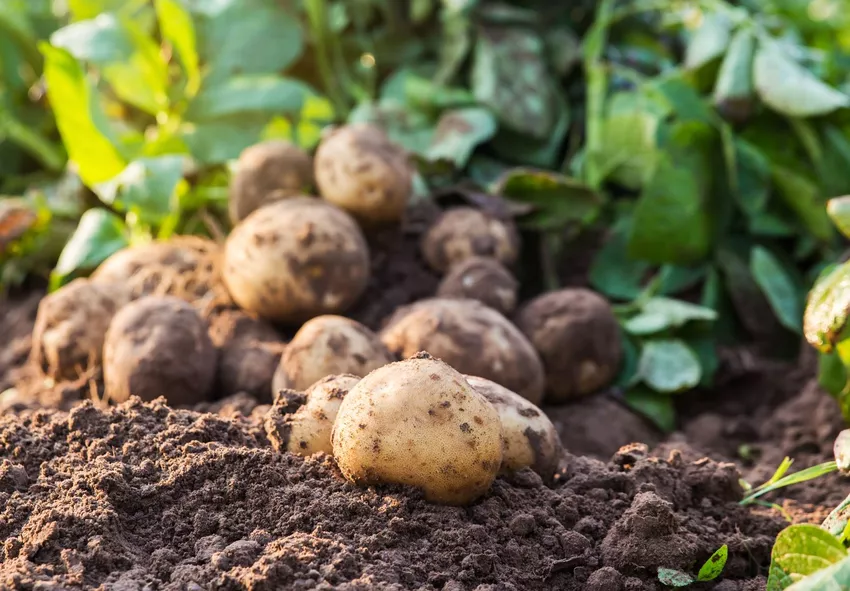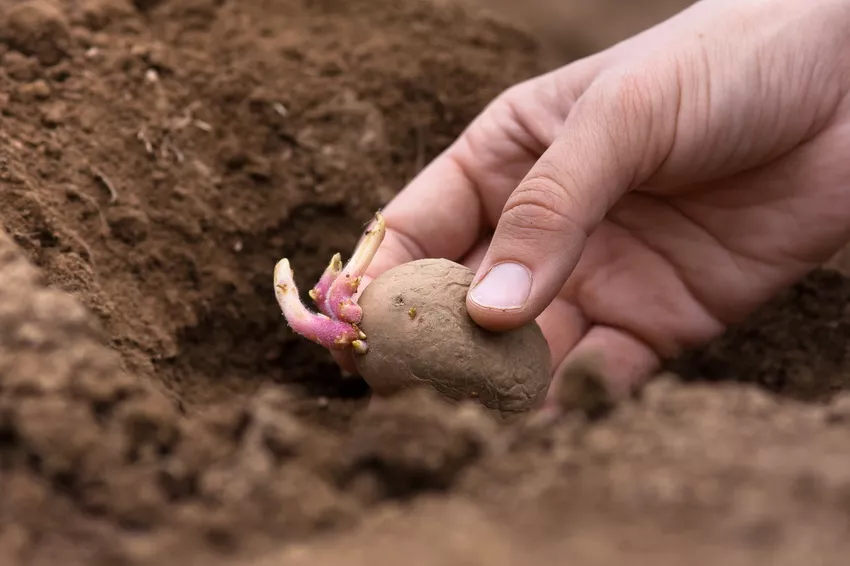Potatoes are versatile and popular. Here you can find out when, how and with what the best way to fertilize the highly consuming potato for a bountiful harvest.

The potato (Solanum tuberosum) is a nightshade plant (Solanaceae) that originates from South America and was brought to Europe by seafarers about 400 years ago. Since then, the tuber vegetable has been an important foodstuff that is also grown in many home gardens. For sufficient growth and a rich harvest, however, the heavily consuming potato plants must be optimally supplied with nutrients.
When is the best time to fertilize your potatoes? Which fertilizers are suitable and how do you go about fertilizing correctly? We have summarized the most important information for you.
When is the best time to fertilize the potatoes?
Basically you should know that potatoes are not grown from seed, but from seed potatoes or he althy storage potatoes that have not yet sprouted. Each "mother potato" forms runners, which in turn can form up to twelve new tubers. Due to its high nutrient requirements, this tuber vegetable is ideally suited as a first crop in the garden year. The first fertilization is best done when planting in spring. A basic distinction is made between early and late potato varieties.
Tip: In our special article you can find out what other measures you should take to care for potatoes in addition to fertilizing.
Early potatoes grow relatively quickly, can be harvested as early as June and are then suitable for immediate consumption. Once the soil has warmed up enough, you can plant the pre-germinated tubers and fertilize them for the first time. The planting and fertilization of late varieties for the main harvest in autumn, on the other hand, only takes place from the end of April to the beginning of May. After two months at the latest, you should fertilize again in order to optimally supply the potatoes with nutrients. In order to protect plants, soil and animals in the garden, it is best to use organic long-term fertilizers in organic quality. The optimum amount of fertilizer can vary depending on the productbe different. Therefore, always take into account the respective information provided by the manufacturer.

Tip from the professional: For an optimal start of the young potato plants, it has proven useful to work some rotted manure or compost into the soil as early as autumn.
Potato fertilizer: How and with what to fertilize potatoes?
A rich harvest can only be achieved if the potato is sufficiently fertilized. However, over-fertilization or imbalanced fertilization is also not desirable and can also lead to an increased susceptibility of the plant to potato diseases. Below we present some options for optimal fertilization.
Fertilize potatoes organically
It makes sense to use organic slow-release fertilizers in your own garden, both from a scientific point of view and from the point of view of sustainability. These consist to a large extent of organic material, which serves as food for soil organisms and is gradually broken down by them. The nutrients contained are made available to the plant and at the same time the soil structure is sustainably improved. By dispensing with chemicals, the fertilizers are also particularly gentle on the environment.
Our Plantura organic tomato fertilizer meets all of these criteria and is also characterized by its sustainable production and easy dosing. The nutrient content of the fertilizer depends on the needs of heavily consuming vegetables. It is therefore also ideal for fertilizing potatoes. The granular form also ensures that all important nutrients are naturally available to your plant immediately and over the long term.

To ensure that your plant is optimally supplied with nutrients, we have prepared detailed instructions for you below.
Organic Long-Term Fertilization: Instructions and Dosage Amounts for Potatoes
- Before planting: Work 100 - 180 g/m² of our Plantura organic tomato fertilizer into the top soil layers
- Water well after planting so that the granulate can loosen
- After 2 months you should fertilize another 80 - 120 g (7 - 10 heaped tablespoons) per plant
Fertilize potatoes with minerals: blue grain, calcium cyanamide and Co.
Mineral fertilizers are easily soluble and can be directly absorbed by the plant. However, the amount of fertilizer selected should be adapted to the nutrient requirements of the plant. This can prove to be relatively difficult with these fertilizers. Therefore, there is also an increased risk of over-fertilization and leaching of nutrients. In addition, the fertilizer s alts harm soil life: the amount of nitrogen-fixing bacteria decreases and earthworms disappear.

Lime fertilization for potatoes is also discussed controversially. Experts are of the opinion that fertilizer promotes plant diseases. However, proponents emphasize the benefits such as increased yields and quality gains. The lime increases the pH of the soil and the ammonium supplies the plant with nitrogen for a longer period of time. Calcium cyanamide, often offered as "Perlka", should only be used with caution and, above all, early enough before planting (at the latest three weeks before). However, the high price of the fertilizer is usually not in reasonable proportion to its effectiveness.
Fertilize potatoes with home remedies
Proven household remedies and natural fertilizers from the garden can also contribute to the supply of nutrients to your potatoes. When planting, you can sprinkle some compost over the tubers before covering them with soil. However, you can also work compost or stable manure into the soil as early as autumn. Due to the beginning decomposition over the winter, the nutrients are immediately available to the plant in the spring. During the flowering period, plant manure that you have prepared yourself can also have a supportive effect. Nettle manure is rich in nitrogen and, when supplemented with potassium-rich comfrey manure, becomes an effective plant strengthener. It is best to dilute the manure with water in a ratio of 1:10 and water the plants once a week in the morning or evening.

Tip from the professional: The effect of the plant manure can be further enhanced by mulching nettle and comfrey leaves.
Summary: How and with what to fertilize the potatoes?
- The first fertilization should already be done when planting out by working compost or organic slow-release fertilizer into the soil
- Organic long-term fertilizers - like our Plantura Bio-Tomato fertilizer - promote soil life and provide the potato plant with long-term nutrients
- Mineral fertilizers promise a quick effect, but there is a risk of over-fertilization and ultimately damage soil organisms
- Natural fertilizers (compost, manure, plant manure) provide the plant with additional nutrients
Green manuring and crop rotation for potatoes
To improve the soil, you can sow green manure before planting in autumn. Legumes such as peas (Pisum), clover (Trifolium) and vetches (Vicia) are particularly suitable for this. ). They transport nutrients (especially nitrogen) from deeper soil layers upwards and at the same time loosen the soil with their roots. Since these plants are not frost hardy, they die back over the winter and can be incorporated into the soil in spring. Due to the high nutrient requirement, it is advisable to plant the potatoes in a different bed at least every four years. Once the new potatoes have been harvested, you can use the bed for other types of vegetables in the summer. Various types of cabbage (Brassica), for example, are suitable replacement crops. Alternating planting avoids a one-sided nutrient removal from the soil and the spread of pests - such as the Colorado potato beetle (Leptinotarsa decemlineata) - bent forward.

Tip from the professional: Potatoes also thrive particularly well in mixed cultures. For example, you can sow spinach between the rows, chop it off later and leave it as mulch. This saves you weeding and the roots can remain in the ground as humus.